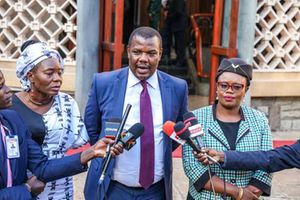Need to foster inclusive campaigns during the period of vote-hunting

More than a billion people — 15 per cent — have some form of disability.
Following the electioneering period in Kenya, it is essential to take stock on how inclusive and accessible campaign messaging was for persons with disabilities (PWDs).
Among the many manifestos published in the run-up to the August 9 General Election, it’s unfortunate that none was translated into braille to aid access by people with visual impairment. And most of the many public service announcements run and paid for on broadcast media lacked the captioning of a sign language interpreter to speak to people with hearing impairment.
This is despite the provisions of the Constitution, at Article 54, on inclusive reporting. The Public Relations Society of Kenya would have had an impact on many aspirants through its contextualised disability mainstreaming capacity building courses.
First, strategic communication practitioners ought to enhance communication etiquette by educating the electorate on how to improve communication for PWDs to discard and disprove myths that can classify them in a separate “class”. Undoubtedly, some people still have negative stereotypes and misconceptions about PWDs that obscure their brand identity. Therefore, it’s essential to use appropriate terms that foster positive attitudes about PWDs by referring to them using the “people-first” language.
Disability
People-first language emphasises the person, not the disability. By placing the person first, the disability is no longer the primary defining characteristic of an individual but one of several aspects of the whole person. For example, it’s preferred to say “people with disabilities” instead of “the disabled”.
Secondly, is the deliberate and intentional use of communication aids and alternative documentation formats. Typically, in the form of large print, braille, audio tape and computer disk. The original campaign publications should include information about the available alternative formats.
More so, people with hearing impairment or are hard of hearing may use a sign language or oral interpreter during campaigns. Interpreters can be used for one-on-one conversations, group meetings and conferences. By virtue of there being several types of interpreters, campaign managers must be conversant with the appropriate choice and, if not sure, inquire from people with hearing loss.
Furthermore, caption messages during announcements or on online campaign platforms. Over time, the Communication Authority of Kenya (CA) has enforced captioning during national news broadcasts, serving as a pacesetter for advocating inclusive reporting. Several shared online platforms, including Microsoft Teams, Google Meet and Zoom, can create captions using artificial intelligence (AI). For online campaigns, campaign managers must inform their participants about the inbuilt assistive capabilities.
Accessibility of social media ought to depend on both platform and content. To insert alt text, for example, social media platforms require different steps. Check platforms for updates on accessibility features. If alt text cannot be attached to an image, include alt text in the caption or post details.
It’s noteworthy that hashtags should use the ‘CamelCase’ style. The first letter of every word is capitalised—as in #NothingAboutUsWithoutUs or #LeaveNoOneBehind—to enable screen readers to read the hashtag correctly. Websites for the aspirants ought to be universally accessible and inclusive.
Campaign managers, in collaboration with web developers, ought to make reference to and adhere to the provisions of the web content accessibility guidelines (WCAG).
Communication techniques
Messaging for PWDs has the potential to evolve. Essentially, if we have to leave no one behind, campaigns ought to embody the accessible communication techniques provided for by the UN’s “Disability-Inclusive Communications Guidelines” as well as the African Union’s “Disability Inclusion Guide”.
Numerous aids and accommodations are available to enable successful communication by campaign managers and their teams .
Ms Marangu is a communication and public policy analyst; [email protected]. Mr Gimode is a communications for development (C4D) expert; [email protected].





